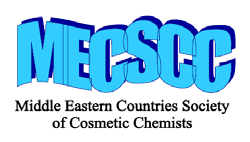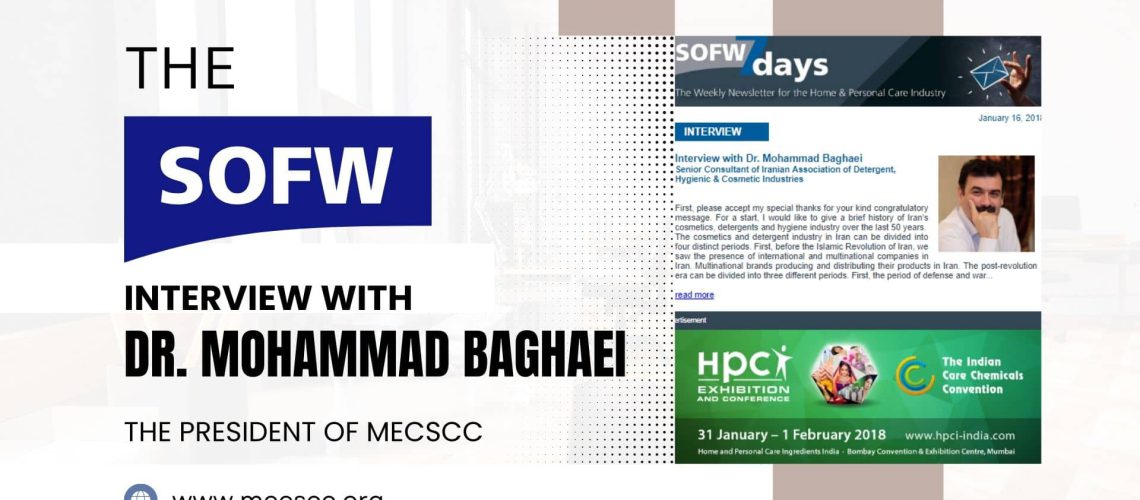The SOFW interview with Dr. Mohammad Baghaei
The president of MECSCC and Senior Consultant of the Iranian Association of Detergent, Hygienic & Cosmetic Industries
Dr. Baghaei, you have become a Senior Consultant of the Iranian Association of Detergent, Hygienic & Cosmetic Industries recently. Congratulations!
Can you tell us something about the Iranian cosmetics, detergents, and hygiene industry?
First, please accept my special thanks for your kind congratulatory message. For a start, I would like to give a brief history of Iran’s cosmetics, detergents, and hygiene industry over the last 50 years. The cosmetics and detergent industry in Iran can be divided into four distinct periods. First, before the Islamic Revolution of Iran, we saw the presence of international and multinational companies in Iran. Multinational brands producing and distributing their products in Iran. The post-revolution era can be divided into three different periods. First, the period of defense and war. In this course, we were only thinking about meeting the basic needs of the people of the country. At this time, Iran was completely sanctioned by Western countries, and our first concern was to defend the borders of our country.
Second period: The period of sustainability and restoration of the industry. The industries that needed to be restored after the war. During this period, the universities were looking to solve the industrial problems. But the country needed investment and time to rebuild industries. But the third period we are currently in is the period of development and innovation. A period of more than ten years has already begun. In the third period after the revolution, good communication was established between universities and industries. You know, the cosmetic and detergent industries are very knowledge-based. And you know that our country has well-known universities and specialists in the fields of pharmacy, chemistry, medicine, etc. Of course, at the 13th Asian Conference of cosmetic Associations, we were also witnessing their active participation in the articles. Today, we have the ability to produce all cosmetic products and detergents in our country. And there is no particular problem in the formulation and production of new products.
What are the main challenges for the Iranian Home and Personal Care industry?
What’s important for Iran today is reducing production costs and increasing productivity as well as improvements that must be made on the basis of the transfer of new technologies. When we talk about technology transfer, we do not mean transferring of shampoo, lotion, and creams producing machinery, but we mean the transfer of advanced technologies in the manufacture of raw materials or devices that add to the quality of the product.
What are your expectations for the Detergent, Hygienic & Cosmetic industries in Iran?
Our industry is now waiting for new global proposals to jointly contract new products and export them to regional and global markets. Of course, I think it is better to have these modifications, and that way, our business partners are committed to exporting Iranian brand goods too. We have many research and study capacities in our universities in our country that can be put into effect on the basis of contracts for these common goals. On the other hand, you know, Iran is the source of unique plants that can be the subject of joint research. It is worth noting that everyone says that Iran is the second-largest consumer of cosmetic products among the Middle Eastern countries. Yes, it is completely correct, but we also know that Iran is the largest and best producer of these products in the Middle East. Currently, a large part of the Iranian market is at the disposal of smuggled and counterfeit goods, but with the government’s policies, the scope of these products is narrowing down on these products, while the conditions for the production and import of legal products of the main products will be better.
How strong is the Iranian market in these fields?
According to current statistics, Iran currently has more than 15 million cosmetics consumers, and this population is constantly rising. Almost 4.5% of Iranian families’ yearly income is spent on Cosmetics and skin care products. The Iran’s cosmetics market value is estimated to be around $4 billion which makes Iran the #7 consumer of cosmetics and skin care products, in the world.
How can foreign companies enter the Iranian market?
Today, government policies are in place to support domestic production, and global companies, based on the model described above, can participate with Iranian active companies. As producers of cosmetics products, we are never against the legal import of these products into the country because we can model them, and with the presence of international brands, we can jointly introduce our products in the region and the world. But we believe that these imports should be within the framework of our national and regional goals in support of the domestic industry. Different companies in the world can cooperate with Iranian companies in relation to equipping and developing lines of production and transfer of modern technologies for the supply of raw materials for the production and manufacture of raw materials. Of course, I have to say that there are good machinery manufacturing companies in our country that can cooperate with them.
The Iranian Association of Detergents and Hygienic and cosmetics industries was officially established 21 years ago and currently has about 200 permanent members. Its members are manufacturers of a variety of products, including detergent powders and detergent liquids, cosmetic and hygienic products, and raw materials for these industries./.


